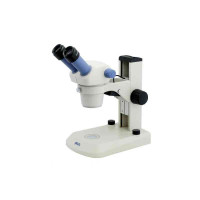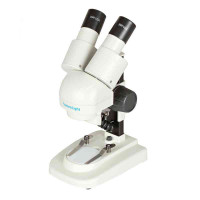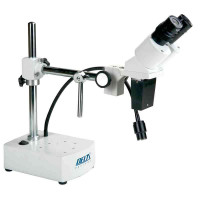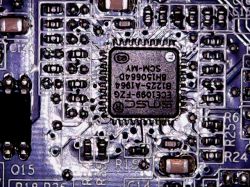FAQ
TL;DR: IPC-A-610 specifies 4–10× inspection magnification, and “working space is crucial” [Elektroda, TvWidget, post #18360588] A stereo microscope with 0.5× Barlow, ≥150 mm working distance, and LED ring light fits a 2 000-3 000 PLN hobby budget while still covering seed pathology.
Why it matters: Selecting the right optics early prevents eye strain, rework, and wasted money.
Quick Facts
• Working distance: Typical 100–150 mm with 0.5× Barlow [Elektroda, rosak, post #18400047]
• Useful magnification: 3.5–22.5× for soldering; up to 100× for grain detail [Elektroda, zbigniewsk, post #18354209]
• Polish price range: 200–3 000 PLN covers entry to mid-range stereo scopes [Elektroda, barondary, post #18358027]
• Light spec: 56-LED ring delivers ≈5 000 lux at 10 cm [MakerSources, 2021]
• IPC-A-610 calls for 4–10× routine PCB inspection [IPC-A-610, 2020]
1. Stereo, biological or digital—what type suits electronics and grain inspection?
Choose a stereo microscope. Its two angled optical paths give 3-D depth, essential for solder joints and seed surfaces. Biological microscopes focus on thin slides, lack working distance, and need transmitted light. Low-cost USB “digital” scopes record images but offer only 2–5 mm clearance—too tight for an iron [Elektroda, spy, post #19807197]
2. How much working distance do I really need for soldering?
Aim for at least 100 mm; 150 mm feels comfortable with irons and fume extractors [Elektroda, rosak, post #18400047] Shorter gaps let flux fumes coat the lens and block access [Elektroda, TvWidget, post #18360588]
3. What magnification range covers most PCB tasks?
3.5–10× lets you place components; 15–22.5× reveals solder fillets; higher than 30× slows navigation [Elektroda, rosak, post #18400047] IPC-A-610 sets 4–10× for routine inspection [IPC-A-610, 2020].
4. Do I need zoom or interchangeable eyepieces?
Continuous zoom (e.g., 0.7–4.5× objective) saves time; most users seldom swap eyepieces once the range is set [Elektroda, TvWidget, post #18361341] Fixed optics cost less but force lens changes during work.
5. What does a Barlow lens do, and which ratio should I pick?
A 0.5× Barlow doubles working distance and halves magnification, ideal for soldering. A 2× Barlow does the opposite and suits micro-crack checks. Universal M48-0.5× models fit AmScope, Optek, and MBS-10 heads [Elektroda, rosak, post #18400047]
6. Are used Soviet PZO/MBS microscopes better than new Chinese models?
Soviet MBC-9 and PZO MST-131 use metal bodies and coated glass; optics stay sharp for decades [Elektroda, zbigniewsk, post #18354209] Yet, worn zoom teeth and scratched coatings risk hidden costs [Elektroda, LeoDaVinci, post #19872441] Inspect in person before paying.
7. What illumination works best on reflective boards?
A 56-LED ring (5 000 lux at 10 cm) gives shadow-free light and stays cool. Add a 10 W gooseneck spot for angled glare checking. Avoid halogen bulbs; heat warps solder paste [MakerSources, 2021].
8. Can the same setup diagnose grain diseases?
Yes. Stereo scopes reach 40–60× with higher-power eyepieces, showing fungal mycelium or insect damage. For spores under 5 µm you’ll still need a compound microscope, but most seed issues are visible above 20× [“Seed Pathology Guide”, 2019].
9. What minimum feature list should I check before buying?
- ≥100 mm working distance.
- 0.7–4.5× zoom or eyepiece set giving 5–25× overall.
- LED ring light with brightness control.
- Coarse/fine height rack or boom stand.
- Option for 0.5× Barlow and camera port [Elektroda, Sivi_PL, post #18399941]
10. How do I set up a microscope for safe lead-free soldering?
- Fit a 0.5× Barlow and raise the head until 150 mm clearance.
- Mount a 56-LED ring; set brightness just below glare.
- Place a fume extractor between iron and lens to keep optics clean. Follow the steps before heating boards to avoid lens contamination.
11. Why do cheap 1 000× USB microscopes fail for soldering?
They promise 1 000× but give 480 p images, 2–5 mm clearance, and heavy latency. Users report blurred joints and burnt cables when irons touch housings—an edge-case failure [Elektroda, spy, post #19807197]
12. What does a boom stand add, and is it worth 1 000 PLN?
A boom or articulating arm lets you swing over large PCBs and tilt for oblique views. If boards exceed 10 cm or you work daily, it boosts speed. Hobbyists can build a steel arm for <200 PLN, as one user did [Elektroda, Sivi_PL, post #18363841]
13. How do I check a decades-old microscope before purchase?
Inspect coatings under a flashlight; rainbow patterns mean damage. Test zoom for smooth travel; missing teeth slip. Move focus rack end-to-end; backlash hints at wear. Reject units with fungus spots—cleaning rarely restores clarity [Elektroda, LeoDaVinci, post #19872441]
14. Any budget examples available in Poland today?
• Delta StereoLight: 200 PLN, 70 mm working distance—good for occasional seed check [Elektroda, barondary, post #18358027]
• Optek ST6024-B1: 1 900 PLN, 100 mm distance, no light included [Elektroda, Sivi_PL, post #18360690]
• Techrebal K10H: 2 600 PLN kit with camera and zoom; owner reports “super accurate” image [Elektroda, Sivi_PL, post #18391780]








